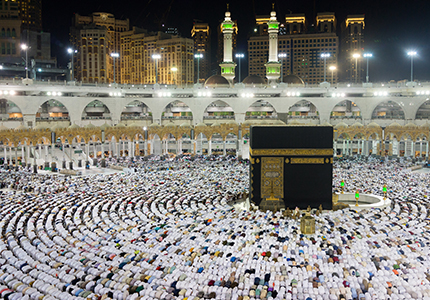
To Muslims Makkah is regarded the holiest city in the religion of Islam and a pilgrimage to it known as the Hajj is obligatory for all able Muslims. Makkah is home to the Kaaba, Islam's holiest site, used as the direction of Muslim prayer. Makkah used to be ruled by descendants of prophet Muhammad (pbuh) , known as the Sharif’s, acting as either independent rulers or as leaders to larger polities. In 1925 Makkah was conquered by Ibn Saud. Today Makkah has seen tremendous expansion in size and infrastructure, structures including the Abraj Al Bait, also known as the Makkah Royal Clock Tower Hotel, the world's third tallest building and the building with the largest amount of floor area. During this expansion, Makkah is home to many Islamic historical and archaeological sites. More than 15 million Muslims visit Makkah annually, including several million during the few days of the Hajj. Makkah has become one of the most diverse cities in the Muslim world, despite the fact that non-Muslims are prohibited from entering the city.
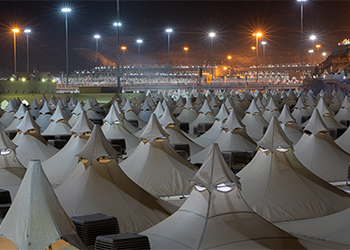
Mina is located in the East of Makkah and is a 5km valley. During Hajj, the pilgrims stay in this valley on 8th of Dhul Hajj and then on 10th to 13th of Dhul Hajj.
Mina is well known for how busy it gets during the annual Hajj pilgrimage and also known as the “tent city”. More than 100,000 air-conditioned tents provide temporary accommodation to visiting pilgrims during the blessed Hajj days. The Jamarat Bridge is situated in the valley of Mina, this is the location of the Stoning of the shaitan ritual, performed between sunrise and sunset on the last day of the Hajj. Mina is the place where pilgrims throw stones, in memory of the occasion that the Prophet Ibrâhîm stoned the shaitan when he tried to come between him and the command Allah had set him.
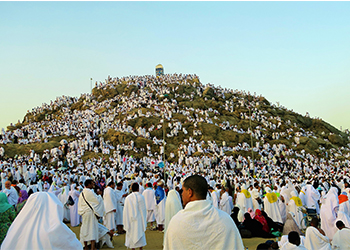
Arafa’ or Arafat is a valley outside Makkah and is around 20km. On the 9th of Dhul haj, it is mandatory for all the pilgrims to reach and stay in the valley of Arafa’ and spend the day in making dua’s, doing dhikr and asking Allah (SWT) for forgiveness for all their sins; not doing so can invalidate their hajj. Jabal ur Rahamah or the Mount of Mercy is a mountain in the valley of Arafat and is about 70m high. The Prophet Mohammed SAW stayed on this mountain and made waqoof. Masjid e Nimra is a beautiful mosque. Two thirds of this mosque lie in the valley of Arafat while one third in the valley of Nimra and the valley of Urana’. The Sermon of Hajj today is delivered in Masjid e Nimra. Our Prophet (peace and blessings of Allah be on him) delivered the Sermon of Hajj while sitting on his camel (Quswa) in the valley of Urana’.It is mandatory for the pilgrims to offer Qsr and combined prayers of Dhur and Asr after the Sermon of Hajj in or around Masjid e Nimra, and then reach the valley of Arafat and make waqoof there, spending their time in making dua’s, dhikr and asking for forgiveness.
Arafat is a blessed place during Hajj and is the best place to make dua; on the 9th of Dhul hija it is known to be the best time to make dua and the best dua to make according to one hadith: It is better to make dua in the valley of Arafat while facing Qibla and raising your hands. If a person is late in reaching the valley of Arafat, but manages to spend some time in waqoof during the night between 9th and 10th of Dhul hija before Fajr, his Hajj is validated. It is a sunnah not to fast on the 9th of Dhul hijj if you are a Hajj pilgrim. However, if you are not a pilgrim, then fasting on 9th of Dhul hija is Mustahab and it expiates all the sins of the previous year and for the next year, according to one hadith.
[1] Sahih Muslim, Kitab ul Hajj, Hadith: 1218
[2] Tirmidhi, Kitab udda’waat, Hadith : 3585
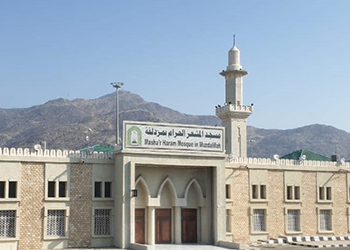
Muzdalifah is located in the province of Makkah. It is mostly a flat land and lies between Mina and Arafat. During hajj, pilgrims travel from Mina to Arafat on the 9th of Dhul Hijjah. They spend the whole day at Arafat and after sunset they leave for Muzdalifah , all the while reciting talbiyah. When pilgrims reach Muzdalifah they perform the Maghrib prayer, they can stay where ever they are. At Muzdalifah, the pilgrims sleep in open air and wake up early for fajr prayer just after Subh’ Sadiq. There is a hill in Muzdalifah known as “Mashar-ul-Haram”. It also has a mosque built on it. It is masnoon to make dua near Mashar-ul-Haram while facing the Qibla. Nowadays, the starting and ending boundary lines for Muzdalifah have been highlighted clearly so that the pilgrims know the area in which they are required to spend the night and to make duas. According to one hadith narrated by Arwa (RA), anyone who is able to offer fajr salah in Muzdalifah, has accomplished his Waqoof-e-Muzdalifah. Shortly after fajr prayer, the pilgrims leave for Mina. For the very old, sick or young children, it is permissable to leave Muzdalifah after the moon sets down, before the time of Fajr prayer starts. Pilgrims also collect pebbles for stoning the Jamarat at Muzdalifah. However, the pebbles for Our Prophet (peace and blessings of Allah be on him) were collected by Ibn Abbas (RA) from Mina.
There is a valley between Mina and Muzdalifah, called Wadi Muhasser. It was here that the army of Abraha and his elephants met the Wrath of Allah (SWT), the incident which is mentioned in Surah Al Fil in the Quran.
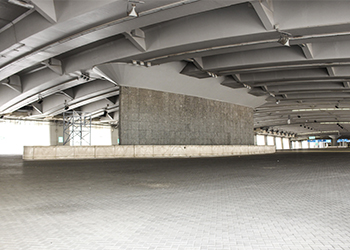
The Jamarat or stoning of the Shaitan (devil) is an important part of Hajj. The Jamarat used to firstly be three tall pillars in Mina, but since 2004, they have been replaced by high walls to avoid any accidents. Also a (one way) bridge has been made to make it easier for the Hujjaj (pilgrims) to pelt the Jamarat either from the bridge or from the ground. The three walls or Jamarat are named ; Jamarah-al-Oola or Jamarah-e-Sughra (meaning the first or the small Jamarah), Jamarah-al-Wusta (meaning the middle Jamarah) and Jamarah-al-Uqbah or Jamarah-al Kubra ( meaning the last or the largest Jamarah).
Hajj is an Ibadah that is a collection of rituals that commemorate the Sunnahs of Ibraheem (AS) and his family. Pelting the Jamarat represents the steadfastness of Ibraheem (AS) and Isma’eel (AS). When Ibraheem (AS) saw a dream for three consecutive nights that he was sacrificing his only son. He knew that as a Prophet, his dreams were true and a form of Wahi (revelation). So he took his son, Isma’eel (AS) along with him. On their way, he told his son about the dream. The son readily agreed to be sacrificed to please Allah.
Ibraheem (AS) and Isma’eel (AS) were walking towards Mina, they were approached by Shaitan. Shaitan tried to whisper and persuade Ibraheem (AS) not to sacrifice Isma’eel (AS). Shaitan appeared before Ibraheem(AS) three times at the points the Jamarat stand now. All three times he was pelted with stones by Ibraheem (AS) to ward him off and he remained steadfast to foolow the comman of Allah (swt) to sacrifice his son. When Ibraheem tried to sacrifice Isma’eel (AS), Allah was mightily pleased with him and blunted his blade. Ibraheem (AS) was sent a Ram from heaven to be sacrificed instead of Isma’eel (AS). For these reasons, the Hujjaj pelt stones at the Jamarat to commemorate the Sunnah of Ibraheem (AS).
Ideally, Hujjaj should be standing in such a way that on their left there is Makkah and on their right, there is Mina. But if it is impossible, stoning can be done in any position. Stoning of Jamarat starts on the 10th of Zil hajj. On the first day, only Jamarah-al-Uqbah is pelted with seven pebbles (usually collected at Muzdhalifah). Each pebble is thrown by saying AllahuAkbar.
On the 11th, 12th and 13th of Zilhajj, all three Jamarat in the sequence; Jamarah-al-oola, Jamarah-al-Wusta and Jamarah-al-Uqbah are pelted with seven pebbles each. After stoning each Jamarah, making dua is Musnoon, but no dua should be made after pelting the last Jamarah.
References:
[1] Surah Madinah-Saffaat 37: verse -102
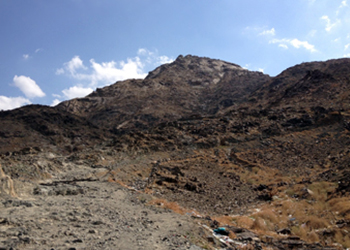
When the Prophet (SAW) and Abu Bakr (RA) arrived at the cave on Mount Thawr, Abu Bakr (RA) entered first to clear away anything that might injure the Prophet (SAW). He found a few holes and stuffed them with pieces of cloth. The Prophet (s.a.w.) then entered and went to sleep on Abu Bakr(RA)’s lap. Suddenly, something stung Abu Bakr(RA)’s foot, but he did not twitch, fearing he would wake the Prophet (SAW). The pain was so intense that tears began to run down his cheeks and onto the Prophet (SAW)’s face. The Prophet (SAW) woke up and saw that Abu Bakr (RA) was in pain. He applied his spittle on the injury and the pain disappeared.
For three consecutive nights the Prophet (SAW) and Abu Bakr (RA) remained hidden in the cave. During this period, Abu Bakr (RA)’s son, Abdullah, would pass his nights nearby. The young man would return to Makkah very early in the morning so that the Quraysh had no idea that he had slept elsewhere. Each day in Makkah he collected information about the activities of the Quraysh, and each night went back to Jabl Thawr to inform the Prophet (SAW) and his father Abu Bakr (RA).
Abu Bakr (RA)’s slave, Amir bin Fuhayra (RA), would graze Abu Bakr (RA)’s goats near the cave so that both men could drink fresh milk. Early the next morning Amir would drive the goats back to Makkah along the same route that Abu Bakr (RA)’s son took, to obscure his footprints.
When they were inside Allah (SWT) sent a spider to spin a web from a bush across the entrance to the cave. Allah (SWT) also commanded two doves to fly down between the spider and the tree, make a nest and lay eggs. Meanwhile the Quraysh search party scoured the area south of Makkah where the Prophet (SAW) and Abu Bakr (RA) where hiding. They came upon the mouth of the cave, and had they looked down while standing at the edge of the cave, they would have surely found the men they were hunting.
With the Quraysh so close to discovering their hiding place, Abu Bakr (RA) became very tense about the Prophet (SAW)’s safety. The Prophet (SAW) reassured him, “How can you be apprehensive about two with whom is a third, especially when the third one is Allah?”
On seeing the spider’s web and dove nest, the Quraysh concluded that no one could have entered the cave and left. Describing this amazing incident the Quran mentions in Surah Taubah:
“If ye help not (your leader), (it is no matter): for Allah did indeed help him, when the Unbelievers drove him out: he had no more than one companion; they two were in the cave, and he said to his companion, “Have no fear, for Allah is with us”: then Allah sent down His peace upon him, and strengthened him with forces which ye saw not, and humbled to the depths the word of the Unbelievers. But the word of Allah is exalted to the heights: for Allah is Exalted in might, Wise.“ [9:40]
After three days when they learnt that the search by the Quraysh had petered out. They left the cave and headed towards Yathrib (now known as Madinah) the daughter of Abu Bakr (RA) came to them bringing food for the journey. When they were about to start she could find nothing to tie it to their saddles with and so she undid her waistband, tore it in two, wore half and tied the food with the other half. This ready solution won her praise from the Prophet (SAW) who also named her ‘She of the two waist band’. After that the Muslims knew her by that name.
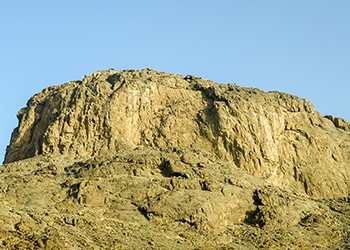
Also known as Mount Jabal Noor (the mountain of light) which lies about two miles from the Kabba. It was here that the Prophet Muhammad (SAW) received the first revelations of the Holy Quran during the month of Ramadan in 610 CE.
The Prophet (SAW) first began to have revelations in the form of good dreams which became true. Then he began to like solitude. He would go to the cave of Hira and meditate there in solitude for a number of days and nights. He would take provisions with him to stay for an extended period, and when he returned to Khadeejah (RA), he would stock up again and go back to the cave. This was his practice until Truth was revealed to him by the will of Allah AWT through an angel while he was in the cave of Hira.
During Tahajjud time one night, when he was alone in the cave, there came to him an angel in the form of a man. The angel said to him, “Recite!”. “I cannot read”, the Prophet (SAW) replied. The angel took hold of him a second time and pressed him until he could not endure it any longer. After letting him go, the angel again said, “Recite!”. Again the Prophet (SAW.) replied “I cannot read”. The angel further embraced him again until he had reached the limit of endurance and said “Recite!” for the third time the Prophet (SAW) said “I cannot read”. The angel released him and said:
“Read in the name of your Lord, the Creator. He Who created man from a clot. Read! And your Lord is the Most Bounteous. Who taught by the Pen, taught man what he knew not.” [96:1-5]
This was the first day of his Prophethood and these were the first verses of the Quran revealed to him. He recited these words after the angel, who thereupon left him; and he said; “It was as though the words were written on my heart.” He was very alarmed by the experience and feared that he had become possessed.
The Prophet (SAW) fled from the cave, and when he was halfway down the slope of the mountain he heard a voice above him saying: “O Muhammad, thou art the Messenger of God, and I am Jibraeel (Gabriel)”. The Prophet (SAW) stood gazing at the angel; then he turned away from him, but whichever way he looked the angel was always there on the horizon, whether it was to the north, east, south or west. Finally the angel turned away. The Prophet (SAW) was terrified and his heart was pounding hard. He returned home to Khadija (RA) and said, “Cover me!” Khadija (RA) covered him and helped him calm down.
The Quran tells us that the first revelation descended in Ramadan on the ‘Night of Power’.
“The month of Ramadan is the month in which the Quran was revealed.” [2:185]
“We have indeed revealed this message during the Night of Power.” [97:1]
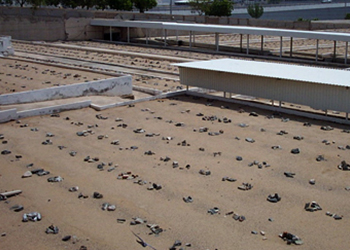
At this place many members of the Prophet (SAW)’s family and many Sahabah (RA) are buried. The following people are said to be buried in this graveyard:
Ummul Mu’mineen Khadeejah (RA), the first wife of the Prophet (SAW)
Qasim, the eldest son of the Prophet (SAW) from his wife Khadija (RA); he died in infancy.
Abdullah, the second son of the Prophet (SAW) from his wife Khadija (RA); he was also known Madinah Tahir and Tayyab.
Abu Talib – the uncle of the Prophet (SAW)
Abdul Muttalib – the grandfather of the Prophet (SAW)
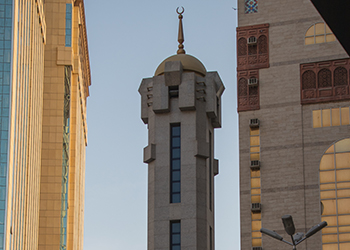
Masjid Jinn is built and located at the place where the Prophet (SAW) drew a line for Abdullah bin Mas’ood (RA) who had accompanied him after he had been commanded to recite the Qur’an to the Jinn:
Abdullah bin Mas’ood (RA) narrates, “While in Makkah, the Prophet (SAW) once said to the Sahabah (RA) “Whoever wishes to see what the Jinn are all about should come along.” Besides myself no-one else came. When we reached the place in the Ma’la district of Makkah the Prophet (SAW) used his foot to draw a circle on the ground. He then instructed me to sit inside the circle. After proceeding a little further, the Prophet (SAW) started reciting the Qur’an. It then happened that Jinn started to arrive in troops and they gathered there. So many came that I could not even see the Prophet (SAW) nor hear him. The Prophet (SAW) then continued talking with a group of them until Fajr, when he came back to me saying, “I have given them bones and dung as their provisions so you people should ensure that you never use bones and dung to clean yourselves after relieving yourselves.”
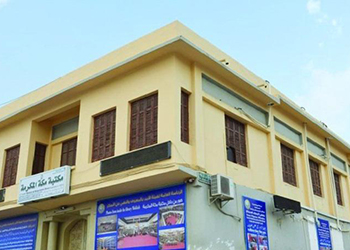
There is no doubt that birth and the life of the last Messenger of Allah(SAW), Prophet Muhammad (SAW) was an incident that has had an effect and influenced the entire human race, whether Muslim or not. Many non-Muslims consider him a person who had great influence on history. In his book, The 100: A ranking of the most influential persons in history, the author Micheal H.Hart placed our Prophet Muhammad (SAW) in first place because he believes Prophet Muhammad (SAW) was “supremely successful in both the religious and secular realms".
Muslims have made a strong effort to preserve every tiny detail and memory of the life of our Prophet Muhammad (SAW). His words and actions were recorded as hadith and sunnah, his biography / seerah. Even his (SAW) ancestry can be traced back to Prophet Ibraheem (AS) and in some books, even to Prophet Adam (AS).
Our Prophet Muhammad (SAW) was born an orphan. His father Abdullah bin Abdul Mattalib died during a business journey to Syria. His mother Amna bint Wahb gave birth to him in her house, in the year of Elephants. This house was located in an area which was well known as “Shaib Bani Hashim”.
It is recorded that when our Prophet (peace and blessings of Allah be on him) migrated to Madinah, Aqil bin Abi Talib took it as his residence. After his death, his children became owners of the house. The house was then sold to Hajjaj Bin Yousaf’s brother, Muhammad bin Yousaf , who made it a part of his larger house and used it as a residence. When the mother of Khalifa Haroon and Musa came to perform Hajj, she converted it into a mosque.
Centuries later the mosque was then converted into a library. The building is now present in the form of Maktaba Makkah tul Mukarrama. It is also known as Bayt al Mawlid.
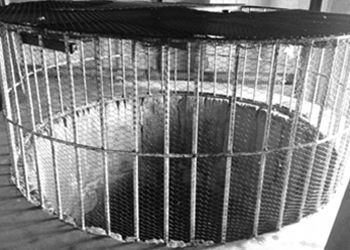
This place is one of the valleys in Makkah . overtime it has developed and is now full of buildings. Its name has been singled to a well in Jarwal, named Tuwa, in which the prophet had spent a night in. After spending the night the prophet (SAW) washed from the wells water before he entered Makkah, interpreted by Al-Bukhari. It is situated at the bottom of Makkah in the north of Jarwal. The word" Tuwa" means the pleated well.
The Prophet (SAW) stopped at this well in Makkah when he performed Hajj. The Prophet (SAW) also bathed in the water of this well. ‘Abdullah bin Zubayr narrates that the Prophet (SAW) said a thousand prophets from the Bani Isra’il tied their mounts at Tuwa and bathed in its water. It is also narrated that the Prophet (SAW) spent the night at this location during the Conquest of Makkah. The next day, the Muslim army was separated into two camps; one under Khalid bin Walid entered Makkah from what is today Khalid bin Walid Road and the other group, led by the Prophet (SAW), entered Makkah from the Kudai side. ‘Abdullah bin ‘Umar would always spend the night at this location when he entered Makkah. Al-Zaraqi said that Zubaydah, the wife of Harun al-Rashid, built a mosque at this location. This well is in the part of Makkah now known as Jurwal.
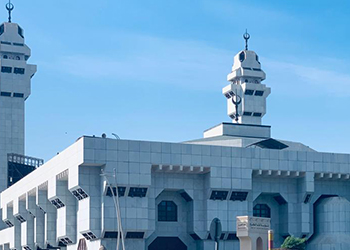
The masjid is located 7.5 km south from Makkah on the road to Madinah and is the closest of all the boundary points (miqat).
Masjid at-Tan’eem is also known as Masjid Aisha and it marks the place where Ummul-Mu’mineen Aisha (may Allah be pleased with her) went to enter into Ihram for Umrah when the Prophet (peace and blessings of Allah be on him) told her to do so during the farewell Hajj.
Jaabir (may Allah be pleased with him) reports that because Aisha (may Allah be pleased with her) was experiencing her menstrual cycle the Prophet (peace and blessings of Allah be on him instructed her to perform all the various rites of Hajj except for the tawaf. She then performed the tawaf after her cycle had ended. She then said, “O Rasulullah (peace and blessings of Allah be on him)! While you have performed Hajj and Umrah, I have performed only Hajj.” The Prophet (peace and blessings of Allah be on him) then instructed her brother Abdur-Rahman (may Allah be pleased with him) to take her to Tan’eem and it was from there that she performed her Umrah after her Hajj during the month of Dhul Hijjah.
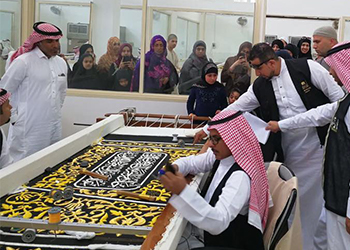
The Holy Kaba is covered by what is known as the Kiswa, and it is one of the most important signs of respect and veneration for the House of God. The Kaba has such an important place in Islamic history and part of the history of the Holy Kaba itself goes back to the time of prophet Ibraheem (AS).
Since the Kaba was first built by Abraham and his son Ismail, the kiswa passed through many stages, and it did not always look like the way we see it today.
Through Islamic history, the form, material and design of the kiswa changed due to social and economic factors related to particular historical periods.
Although there were changes the main factor for the Kiswa has always been for the veneration and respect for the House of God, even in the pre-Islamic period.

This is an amazing exhibition of the Two Holy Mosques’ architecture and relics, in a museum situated amid the hills of Makkah’s Umm Al-Joud area, not far from the Kiswa factory. A visit is one not to miss for you to see its treasure trove of items dating back hundreds of years.
Examples of the most treasured pieces are the doors of the Kaaba that were replaced during various renovations.
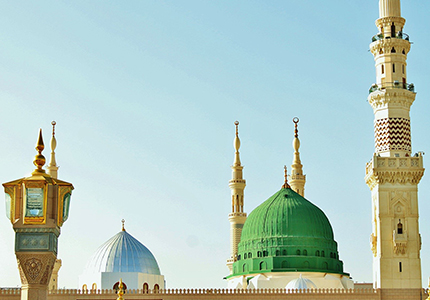
Medina Arabic: المدينة المنورة, al-Madīnah al-Munawwarah, "the radiant city"; or المدينة, al-Madīnah, "the city"). Madīnah, is a city in the Hejaz, and the capital of the Al Madinah Region of Saudi Arabia. The city contains al-Masjid an-Nabawi ("the Prophet's Mosque"), which is the burial place of the last Islamic prophet Muhammad, and after Makkah is the second-holiest city in Islam.
Medina, which was previously known as Yathrib, was Prophet Muhammad's destination after his Hijrah from Makkah, and became the capital of a rapidly increasing Muslim Empire. This Empire was first led by Prophet Muhammad's leadership and then under the first four Rashidun caliphs Abu Bakr, Umar, Usman, and Ali. Madinah served as the power base of Islam in its first century was where the early Muslim community quickly developed. Madinah is home to the three oldest mosques, namely the Quba Mosque, al-Masjid an-Nabawi, and Masjid al-Qiblatayn ("the mosque of the two qiblas"). Muslims believe that the final surahs of the Quran were revealed to the Prophet in Medina, and are called Medinan surahs in contrast to the earlier Meccan surahs.
Non-Muslims are forbidden from entering the sacred core of Medina (but not the entire city) or the city center by the national government, similar to Makkah.
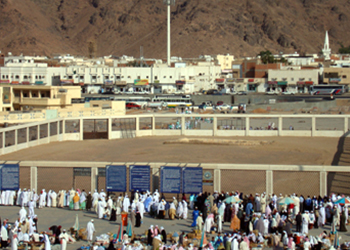
The Ghazwah of Uhud was the second major battle between Muslims and the non-believers of Makkah and was fought in third year of hijrah.
The previous Ghazwah of Badr and defeat was unexpected for the Non-believers of Makkah and particularly the tribe of Quraish; it was a severe blow to their pride. However as a tribe even more important than that was their tradition for avenging their dead. According to their tradition, there could be no peace of heart until the dead were avenged. Hind, the wife of Abu Sufyan, the leader of Quraish, had lost many dear ones in the Ghazwah of Badr, particularly by Hamza bin Abdul Muttalib(RA), uncle of our beloved Prophet (SAW), who was a remarkable huntsman and fighter. She was burning in the fire of revenge. At that time she saw a slave, Wehshi, displaying his amazing skills with a javelin. She promised to set him free if he would kill Hamza (RA).
One day, our Prophet (SAW) got the news that an army of three thousand Non-Believers had arrived near Madinah. A call for Jihad was made. So eager were the Muslims to fight in the name of Allah, that they left their homes and businesses at once to join The Prophet (SAW). The following incident clearly shows the spirits of Muslims. When at the end of battle, people found the body of Hanzlah bin Abu Amer (RA), they found water dripping from it. A messenger was sent to his widow and she confirmed that the newlywed Hanzlah was so eager to join the jihad that he did not even wait to perform Ghusl e Janabat. Our Prophet (SAW) said that that was the reason the angels were bathing him; thus he was given the name “Ghaseel e Malaikah”, one who was bathed by the angels.
An army of seven hundred Muslims reached the field of Uhud first. Our Prophet (SAW) positioned his army such that the mountain of Uhud was at their back. He appointed 50 archers with strict instructions not to leave their positions, no matter what and to guard the pass that went through the Mountain of Uhud.
The Muslims fought bravely and won the first phase of the battle. As the non-believers fled away to save their lives, some archers left their positions thinking that the battle was won. Khalid bin Waleed (RA) who was still a non-believer at that time, led a section of army through the pass of Uhud and attacked the Muslims. The fleeing section of non-believers saw the attack and returned to attack the Muslims from the front. Now the Muslim army was sandwiched between two sections of Non believer armies and suffered heavy losses in the general mayhem and confusion. Wehshi did not fight anyone; he just kept on looking for Hamza(RA). When he found him, according to his own words:
“I held my spear and balanced it well, and then I aimed it. It entered into his abdomen and went out the other side. I waited until he was dead, then I took my spear and went to wait in the camp. I had no quarrel with anyone. I killed him only to be set free.”
Much later when Wehshi embraced Islam, he was always in deep regret of the pain and sorrow he had caused our Prophet (SAW). He eventually came out of his deep regret and sorrow when he killed an imposter Musailmah, who had claimed to be a prophet in the time when Abu Bakr(RA) was the Caliph.
When Hind came to know that Hamza (RA) had been martyred, her joy knew no bounds. She cut his ears and nose and opened his chest; she chewed his liver. Our Prophet (SAW) loved his uncle Hamza(RA) very much and was deeply saddened by his Shahadah, but when he offered peace and pardon to all of the Makkans when the Muslims conquered Makkah, his pardon and peace was for Hind, too. She was deeply moved by this gesture and embraced Islam.
Mus’ab bin Umair was the flag bearer of the Muslims. In those times, the position of the flag bearer was a very important one. If the enemy was able to let the bearer drop the flag, the army thought that it had faced defeat and was demoralized. For the same purpose, a non-believer attacked Mus’ab and cut his arm with his sword. Mus’ab caught the flag with the other arm but did not let it fall. The enemy cut the other arm too but Mus’ab clung to the flag with the left-over parts of his arms. The enemy then pushed the sword through him to kill him but before the flag could touch the ground, another Muslim caught it and became the flag bearer.
When the battle was finally over, the Muslims collected their dead and injured. There were 70 martyrs and shrouds were not available for all of them. The Prophet (SAW) asked them to be buried without the Ghusl as is the custom for the Shaheed. Sometimes two or three martyrs were buried in a single grave. Mus’ab bin Umair was a tall person but the shroud was small. Either his feet or head remained uncovered. Our Prophet (SAW) ordered his head to be covered with shroud, while his feet with the grass of Azkhar.
The graves of Martyrs of Uhud were marked with buildings and tombs that were demolished in the 1970s in accordance with Islamic rules and teachings. Now only an enclosure with unmarked graves of Hamza (RA), Mus’ab bin Umair (RA) and Abdullah bin Jahsh(RA) remains. The rest of the graves of the martyrs of Uhud are behind the enclosure. It is a Sunnah to visit the graves of Uhud and pray for them but it should not include any bid’ah or unIslamic ritual.
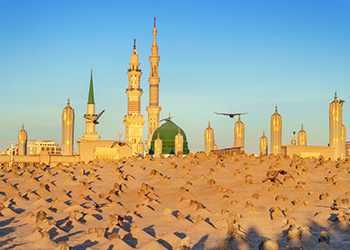
In Madinah its main graveyard is known as “Jannah tul Baqee” or “Maqbaratul Baqee”. It has the high status of being the first Muslim graveyard of Madinah. Several family members of our beloved Prophet (SAW) have been buried in this graveyard. Maqbaratul Baqee is the final resting place of several thousand Sahabah (Companions of Our Prophet [SAW]) too. There are also a lot of well known devout Muslims that have the honor of being buried here.
The location for the graveyard was selected by Our Prophet Mohammed (pbuh) himself soon after he migrated to Madinah when one of his Ansar Sahabah, As ‘ad Bin Zararah (RA) passed away. The graveyard was close to the Masjid-e-Nabwi. The ground of the graveyard used to be completely covered with a thorny bush called “Gharqad” in Arabic. Thus, the graveyard was called “Baqee ul Gharqad”, which means the land of Gharqad. Later, it got famous by the name of “Jannah tul Baqee” or “Maqbaratul tul Baqee”.
Asad bin Zararah (RA) was the first Ansari Sahabi to be buried in Maqbaratul Baqee, while Uthman bin Maz’oon (RA) was the first of the Muhajireen Sahabah to be buried in Maqbaratul Baqee. He passed away soon after the battle of Badr.
Ayesha (RA) reports:
"Rasulullah (SAW) kissed the forehead of 'Uthmaan bin Maz'oon after his death. At that time tears were flowing from his eyes".
This reason for this was the great Sahabi was a foster brother of Our Prophet (SAW). He was the thirteenth person to accept Islam in its early stages. He first migrated to Abyssynia and then to Madinah. He was very pious and devoted. At the time when it was still lawful to drink intoxicants, he had already abstained from consuming it, He was the first among the Muhajireen to pass away. He passed away in Sha'baan in the second year hijri and was buried in the Jannatul Baqee.
'Ayesha (RA) reported said:
(whenever it was her turn for Allah's Messenger (SAW) to spend the night with her) he would go out towards the end of the night to al-Baqee' and say: Peace be upon you, abode of a people who are believers. What you were promised would come to you tomorrow, you will be receiving it after some delay; and God willing we shall join you. O Allah, grant forgiveness to the inhabitants of Baqee' al-Gharqad. Qutaiba did not mention his words: "would come to you".
Another hadith shows that Our Prophet (SAW) was asked to pray for the people of Baqee.
Muhammad b. Qais said (to the people): Should I not narrate to you (a Hadith of the Holy Prophet) on my authority and on the authority of my mother? We thought that he meant the mother who had given him birth. He (Muhammad b. Qais) then reported that it was 'Aisha who had narrated this: Should I not narrate to you about myself and about the Messenger of Allah (may peace be upon him)? We said: Yes. She said: When it was my turn for Allah's Messenger (SAW) to spend the night with me, he turned his side, put on his mantle and took off his shoes and placed them near his feet, and spread the corner of his shawl on his bed and then lay down till he thought that I had gone to sleep. He took hold of his mantle slowly and put on the shoes slowly, and opened the door and went out and then closed it lightly. I covered my head, put on my veil and tightened my waist wrapper, and then went out following his steps till he reached Baqee'. He stood there and he stood for a long time. He then lifted his hands three times, and then returned and I also returned. He hastened his steps and I also hastened my steps. He ran and I too ran. He came (to the house) and I also came (to the house). I, however, preceded him and I entered (the house), and as I lay down in the bed, he (the Holy Prophet) entered the (house), and said: Why is it, O 'Aisha, that you are out of breath? I said: There is nothing. He said: Tell me or the Subtle and the Aware would inform me. I said: Messenger of Allah, may my father and mother be ransom for you, and then I told him (the whole story). He said: Was it the darkness (of your shadow) that I saw in front of me? I said: Yes. He struck me on the chest which caused me pain, and then said: Did you think that Allah and His Apostle would deal unjustly with you? She said: Whatsoever the people conceal, Allah will know it. He said: Gabriel came to me when you saw me. He called me and he concealed it from you. I responded to his call, but I too concealed it from you (for he did not come to you), as you were not fully dressed. I thought that you had gone to sleep, and I did not like to awaken you, fearing that you may be frightened. He (Gabriel) said: Your Lord has commanded you to go to the inhabitants of Baqee' (to those lying in the graves) and beg pardon for them. I said: Messenger of Allah, how should I pray for them (How should I beg forgiveness for them)? He said: Say, Peace be upon the inhabitants of this city (graveyard) from among the Believers and the Muslims, and may Allah have mercy on those who have gone ahead of us, and those who come later on, and we shall, God willing, join you.
Just imagine that Our Prophet (SAW) repeatedly asked for the forgiveness of the people of Baqee! The list of all these lucky people is quite long but the names of some important people are:
1. With the exception of Khadijah bint Khuwaylid (RA) and Maymuna bint al-Harith(RA), all other wives of Our Prophet (SAW) are buried in Baqee. These two wives were buried in Makkah and Sarif respectively.
2. Several children of Our Prophet (SAW) are buried in Baqee. These include: The daughters Fatima (RA), Ruqayyah (RA), Zainab (RA) and Umme Kulthum (RA); the son Ibraheem (RA).
3. Grandson of Our Prophet (SAW) Hassan (RA)
4. Uncle of Our Prophet (SAW), Abbas bin Abdul Muttalib (RA)
5. Aunts of Our Prophet (SAW); Safiyyah (RA) and Aatikah (RA)
6. Companions of Our Prophet (SAW); the list is quite long. Some names are: Saad bin Abi Waqas (RA), Abdur Rehman bin Auf (RA), Abdullah bin Masood (RA), Abu Saeed Khudri (RA)
Over time, many building structures and mausoleums were built to mark the graves of important people. These building structures were completely destroyed in 1925 by King Abdul Aziz Al Saud in accordance with various hadiths and Islamic fiqh.
[1]Narrated by Shamail Tirmidhi, Chapter 44, Hadith 005 (309)
[2]Narrated by Muslim, Book 004, Hadith 2126
[3] Narrated by Muslim, Book 004, Hadith 2127
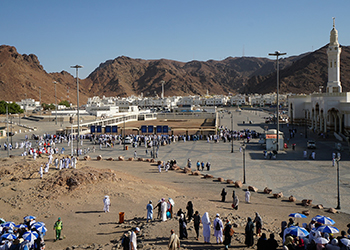
A year earlier and soon after the humiliating defeat in the Battle of Badr, the Quraysh of Makkah made preparations to muster a great army to fight the Muslims again and take revenge. They assembled an army of 3000 soldiers with 300 camels, 200 horses and 700 coats of mail. The Wives and daughters of slained chiefs in Badr traveled along with the army to see with their own eyes the killers being killed. Hind, the daughter of Utbah was the leader of the women’s section and her husband Abu Sufyan was the commander-in-chief of the Makkan army. Both were not Muslims at the time but bitter enemies of Islam. The left and right flanks were commanded by Ikrimah ibn Abi Jahl and Khalid bin Waleed respectively. Amr ibn al-As was named the commander of cavalry and his task was to co-ordinate the attack between the cavalry wings.
(All three subsequently became Muslims and become great generals of Islam).
The Prophet (SAW.) left Madinah for the valley of Mount Uhud with a Muslim army of only 700 and drew up his troops for battle. Zubair bin al-Awwam (RA) was the commander of the right wing and Mundhir bin Amr (RA) was given the left wing of the army. Hamza (RA), the uncle of the Prophet (SAW) was made the advance guard, Mus’ab bin Umair (RA) was chosen as the standard-bearer of Islam and Abu Dujanah (RA) was fortunate enough to receive the Prophet’s sword (which was known as Zulfikar).
The Prophet (SAW) had planned his strategy and put 50 archers under Abdullah bin Jubair (RA) at a mountainside and ordered them strictly to stay there until further orders, whatever may be happening in the battle. They were there to stop the enemy if they attacked the Muslims from the rear.
The two armies faced each other and a fierce battle ensued. The Muslim soldiers concentrated their attack on the eleven standard bearers of the pagans until they were all wiped out. As the enemy standards sank to the ground, the Muslim soldiers hurled themselves against the enemy. Abu Dujanah (RA) and Hamza (RA), fought with great fearlessness, and their heroic feats on the battlefield were to become legendary in Muslim military history.
Tragically, Hamza (RA), the Lion of Allah, was martyred in the same battle he had dominated. He was killed by the javelin of Wahshi bin Harb, an Abyssinian slave, who with that successful throw earned his freedom from his master, Jubayr bin Mutim.
Despite the loss of Hamza (RA), the Muslims managed to overcome the unbelievers who, faced with yet another defeat, began to flee. The pagan women also scattered as some of the Muslim soldiers gave chase.
It was at this point of perceived victory that events began unravelling. The archers who had been instructed to keep their positions and with the safety of their brothers in faith disobeyed the Prophet’s clear orders and deserted their stations, thinking that the battle was over and to claim some bounty. Forty of the rearguards descended the mountain and left the Muslims vulnerable to a counter attack by the enemy.
Khalid bin Waleed saw the sudden opportunity created by the disappearance of the rearguard and his cavalrymen attacked the Muslims from behind, killing many in the process. When the Muslims saw themselves surrounded, they were overtaken by panic and disorder and failed to recover control.
The enemy fought their way close to the Prophet (SAW) who was hit with a rock and fell on his side. One of his lower right teeth was broken, his lower lip was cut, and his helmet was damaged. As an enemy soldier thrust his sword at the Prophet (SAW), he caught his bone below the eye, and two rings from the Prophet’s helmet pierced his face. The blood ran down his face and he wiped it away, saying,
“How can a people prosper who have stained their Prophet’s face with blood while he summoned them to their Lord!”
Mus’ab bin Umair (RA), was targeted by the enemy as he was the Muslims standard-bearer and he was killed. Since Mus’ab (RA) resembled the Prophet (SAW) to a great extent, his killer, Abdullah bin Qam’a, thought he had slain the Prophet (SAW) and jubilantly shouted out that he had killed Muhammad.
Rumors of the death of the Prophet (SAW) filtered through the Muslims, plummeting their morale. Grief stricken and lost, some of them simply abandoned the field, while others were infused with resolve and rallied saying,
“Come, let us die for what the Prophet (SAW) gave his life.”
The crisis receded only when Ka’b bin Malik (RA) caught a glimpse of the Prophet (SAW), making his way to join the besieged Muslims. K’ab recognised the Prophet’s eyes although his face was covered with the helmet. He cried loudly,
“O Muslims, rejoice! Here is the Prophet”.
Ka’b’s words galvanised the remaining Muslims, and they streamed to the Prophet’s side. Within a short time thirty Companions assembled around him. The Prophet (SAW) decided against further combat, wisely choosing to retreat. He made his way through the rows and successfully led his troops towards the mountain pass.
By retreating, the Prophet (SAW) managed to save his army from further losses; losses that had come about from simple disobedience of his orders. Disobedience had changed the Muslim victory into catastrophe, but with Allah’s help the Muslims were pulled back from the edge of disaster.
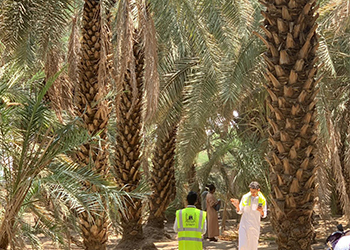
On the day the Prophet Mohammad (saw) passed away, the name of the house is used as shorthand for this event, or the gathering, which was a crucial turning point in the history of Islam.
(June 8, 632 CE), the "Ansar" gathered in the Saqifah to discuss the future and leadership of the Muslims.
The Khazraj and the Aws were the two Ansar tribes and both were present. However, the Muhajir (emigrants) from Makkah, had not been informed of the arranged gathering. When the Prophet (SAW)'s companions, Abu Bakr (RA) and Umar (RA), learned of the gathering, they rushed to the meeting. After a long debate, the details of which are highly contested, those who were present gave their allegiance, or bay'ah, to Abu Bakr (RA) as the new leader of the Islamic community.
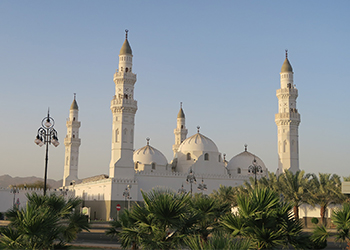
The Prophet (peace and blessings of Allah be on him), accompanied by Abu Bakr (may Allah be pleased with him) after emigrating from Makkah first stayed in a place called Quba on the outskirts of Madinah. They arrived on Monday 12th Rab’i al-Awwal, fourteen years after Prophethood and this date marks the beginning of the Islamic calendar (Hijra), (16th July 622 CE). A masjid no known as Masjid Quba was established here by the Prophet (peace and blessings of Allah be on him), the first to be built in Islam.
1- The virtue of Masjid Quba is mentioned in the following Quranic verse in Surah Taubah: “…certainly a masjid founded on piety from the very first day is more deserving that you should stand in it…” [9:108]
2- The Prophet (peace and blessings of Allah be on him) said: “He who purifies himself at his home and comes to Masjid Quba and offers two rakats therein, will be rewarded the reward of an Umrah (lesser pilgrimage).” [Sunan ibn Majah]
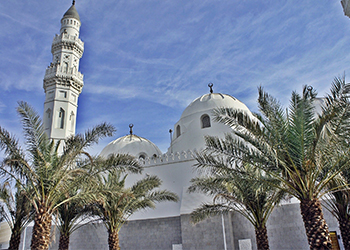
This historical importance of Masjid ul Qiblatain to Muslims is because on Rajjab 2 AH the revelation of the Holy Quran came to change the direction of the qibla from Bait-al-Maqdis in Jerusalem to the Ka’bah in Makkah.
During his time in Makkah, the Prophet Muhammed (SAW) used to pray towards Bait-al-Maqdis, with the Kabba in front of him. When he migrated to Madinah, he prayed towards Jerusalem for 16 months, but he hoped it would be changed to the Kabba.
During Dhuhr prayer or some say Asr prayer, the Prophet (SAW) had led his Companions in praying two rak’ahs , when he was commanded to face towards the Kabba by the following revelation in the Quran in Surah al-Baqarah:
“Verily, We have seen the turning of your (Muhammed’s) face towards the heaven. Surely, we shall turn you to a Qiblah (prayer direction) that shall please you, so turn your face in the direction of Al-Masjid Al-Haram (at Makkah). And where so ever you people are, turn your faces (in prayer) in that direction.” [2:144]
The Prophet (SAW) turned around towards the Kabba and the Sahabah copied out of obedience. Thus the Kabbah became the new qibla of the Muslims for all time to come.
Masjid ul Qiblatain used to uniquely contain two mehrabs, one in the direction of Bait-al-Maqdis and the other towards Makkah. However, the old mehrab has now been covered.
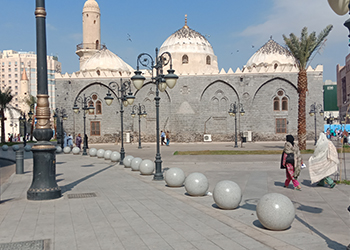
During the last years of his life, The Prophet (SAW) performed Eid Salah at the site that Masjid Al Ghamama is built on.
Masjid Al Ghamama is also known as Masjid Al Eid. According to some reports the Prophet (SAW) performed the Eid salah here during the last four years of his life.
Also at this location, the Prophet (SAW) performed Salatul Istiskah (a special salah for invocation of rain). The word Al Ghamama means clouds which suddenly appeared and brought rain after the Prophet (SAW) had performed the prayer.
According to some reports this was also the spot (or close to this area) where the Prophet (SAW) performed the Janaza (funeral) prayer of Najashi, the Emperor of Aksum in Abbyssinia (Ethiopia). Najashi, although being a Christian, had welcomed the groups of Muslims who had migrated to his country in order to escape the persecution of the Quraysh and later on accepted Islam. When and however he passed away, there was nobody to lead the funeral prayers and so the Prophet (SAW) prayed his Janazah salah, the only time ever he did so in the absence of the actual body.
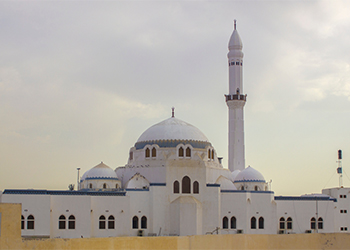
The Prophet (SAW) left Quba on a Friday to head into Madinah. About a kilometer from Quba he passed the village of Banu Salim bin Auf. The people of Banu Salim implored: “O Prophet of Allah, you stayed at the homes of our cousins for a number of days, reward us too with something, for they will pride themselves over us till the Day of Judgement that you stayed with them”. The Prophet (SAW.) dismounted and offered his first Jummah in their locality.
Approximately one hundred Muslims participated in this first Jummah salah. Amongst them were the Prophet’s (SAW) relatives from Bani an-Najjar who had come to meet him and some from Bani Amr who had escorted him from Quba.
After performing the Friday prayer, the Prophet (SAW) mounted Qaswa (his camel) and set off for the city of Madinah.
According to ibn Jarir, he delivered this khutbah (sermon):
“Praise belongs to Allah. I praise Him, ask for His help and seek His Forgiveness and beseech Him for Guidance. I believe in Him and do not reject Him. I despise those who disbelieve Him. And I bear witness that there is no God but Allah, the One, Who has no partner, and that Muhammad is His slave and His Messenger who is sent with guidance and true religion, light and admonition, when there has not been a Messenger for a long time, when knowledge is but little, men are misguided, and end of time is near, death being at hand. He who obeys Allah and His Messenger is indeed guided and he who disobeys them is lost on the wrong path, is fallen down to a terrible misguidance.
And I urge you to fear Allah – the best advice a Muslim may give to another Muslim, urging him to prepare for the Hereafter and to fear Allah. O People; keep away from that which Allah has asked to shun. And there is no counsel greater than that and no remembrance greater than that. Know! For him who fears Allah in his pursuits, the best course is taqwa (righteousness) in affairs of the Hereafter. He who keeps his relationship with Allah, both secret and open, correct – being sincere – that will be an asset for him after death more than zikr in this world. But if anyone fails in that then he would wish that his deeds were kept away from him. As for him who believes and fulfils his promise then;
“The word is not changed with Me, nor do I wrong (My) servants.” [50:29]
Muslims! Fear Allah in what concerns you now and w0hat will follow, in what is hidden and what is open, for, “And he who fears Allah, He will acquit him of his evil deeds and He will magnify reward for him.” [65:5]
And those who fear Allah will gain a mighty success. It is fear of Allah that keeps away His disapproval, punishment and wrath. It is taqwa (fear of Allah) that brightens the countenance, pleases the Lord and raises ranks.
O Muslims! Pursue good fortune but do not lag behind in rights of Allah. He taught you His Book and guided you on the path that the righteous and the false may be distinguished. O People! Allah has been good to you and you should be like that to others. Keep away from His enemies and strive in His cause with determination. He has chosen you and named you Muslims so that he who perishes, does so for worthy cause and he who lives, follows a worthy cause. And every piety is done with His help.
O People! Remember Allah. Strive for the Hereafter. As for him, who corrects his relationship with Allah then Allah correct his relationship with other people.
Know! Allah judges over people but is not judged by anyone. He is their Master but they have no power over Him. Allah is the Greatest. And there is no power (to do good) except with Allah the Mighty.
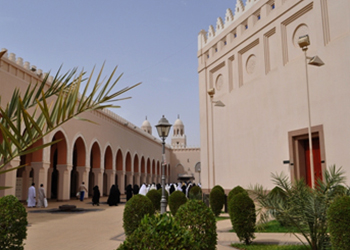
This is a place where pilgrims that are coming from Madinah wishing to perform Umrah or Hajj enter into Ihram before they head for Makkah.
It was first built during the time of Umar bin Abdul Aziz as governor of Al-Madinah (87-93 A.H./706-712 A.D.) and renovated several times afterwards, the last of which was during the time of the Custodian of the Two Holy Mosques, King Fahd bin Abdul Aziz, who ordered its area to be increased several times and to be provided with necessary facilities.
The mosque was built in the shape of a square on an area of 6000 m². It consists of two sets of galleries separated by a wide yard of 1000 m². The galleries are shaped as arches ending with long domes. The mosque has a distinct minaret, square at the bottom but round at the top in a diagonal shape. It rises to a height of 64 m.
Attached to the mosque are facilities for washing, ablution and obtaining ihram clothes. It also has a large parking lot. The Miqaat Mosque, also called Abyaar Ali, is one of the most noticeable spots in Madinah. It is the station for pilgrims from the Prophet’s city and pilgrims passing through it. At this place, they wear their ihram, the two pieces of white cloth that each male pilgrim must wear prior to performing Haj or Umrah, and make the intention of performing Haj or Umrah in Makkah.
This mosque has many names, such as Miqaat, Abyaar Ali, Al-Shajarah Mosque (tree mosque) and Al-Mu’ris Mosque.
The mosque is located within the blessed Aqeeq Valley and is 14 kilometers away from the Prophet’s Mosque.
The mosque was built by the Caliph Umar bin Abdulaziz when he was prince of Madinah and renewed during the Abbassid and Ottoman eras.
It used to be very small and was built with mud and stones, until late King Abdul Aziz ordered it to be expanded and renewed. With the increasing number of pilgrims every year, the mosque became a large station for pilgrims. It is built now on 6,000 sq. meters and consists of two groups of corridors separated by a wide, open space. It can accommodate up to 5,000 persons.